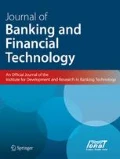Abstract
The financial crisis of 2008, got investment managers to study alternate methods of portfolio construction by focusing on optimisation of risk distribution. In this paper, we introduce a new method of risk diversification of an equity portfolio, based on the individual securities risk contribution. Markowitz’s portfolio optimisation methods were widely believed to diversify the risks until 2010, when it caught the financial market practitioners by surprise. But the scale of misjudgement raised doubts and opened the drawbacks of existing methods in portfolio construction and risk management. In this study, we propose a new technique for portfolio construction and unsystematic risk optimisation, using a well known meta heuristic from evolutionary computation, known as Grey Wolf Optimizer (GWO). We build a portfolio construction model using machine learning methods, to minimise risk contributors from our universe of securities, and then target to increase the asset diversification by maximising the maximum-diversification ratio. We apply boosting techniques to construct portfolio using ensemble of two well known techniques, known as maximum diversification ratio and risk budgeting of portfolio. We have benchmarked our findings by examining the returns of major global indices, and then illustrate our results by comparing with an alternate well known portfolio construction technique, the risk parity portfolio. For comparison, we have considered the length of investment horizon, returns and risks, as factors to present our findings by using the proposed portfolio optimisation and diversification method. Our technique offers practical insights and scope for further investigation into alternate methods of portfolio diversification and risk management using machine learning algorithms.










Similar content being viewed by others
References
Beni G, Wang J (1993) Swarm intelligence in cellular robotic systems. In: Dario P, Sandini G, Aebischer P (eds) Robots and biological systems: towards a new bionics?. Springer, Berlin, Heidelberg, pp 703–712
Bridgewater: the all weather story (1996). https://www.bridgewater.com/resources/all-weather-story.pdf. Accessed Mar 2019
Cai L, Jin Y, Qi Q, Xu X (2018) A comprehensive study on smart beta strategies in the a-share market. Appl Econ 50(55):6024–6033. https://doi.org/10.1080/00036846.2018.1489113
Cesarone F, Tardella F (2017) Equal risk bounding is better than risk parity for portfolio selection. J Glob Pptimiz 68(2):439–461. https://doi.org/10.1007/s10898-016-0477-6 (The Journal of Computational Finance, 1)
Choueifaty Y, Coignard Y (2008) Toward maximum diversification. J Portfolio Manag 35(1):40–51. https://doi.org/10.3905/JPM.2008.35.1.40 (Cited by 102)
Choueifaty Y, Froidure T, Reynier J (2011) Properties of the most diversified portfolio. J Investment Strateg 2:1. https://doi.org/10.2139/ssrn.1895459
Connor G (2000) Active portfolio management: a quantitative approach to providing superior returns and controlling risk. Rev Financ Stud 13(4):1153–1156
Davey K (2014) Building algorithmic trading systems a trader’s journey from data mining to Monte Carlo simulation to live trading. Wiley Trading, Hoboken
Gupton G, Finger C, Bhatia M (1997) CreditMetrics technical document. J.P. Morgan & Co., New York
Investopedia: www.investopedia.com (2019). www.investopedia.com, www.investopedia.com
Markowitz H (1952) Portfolio selection*. J Finance 7(1):77–91. https://doi.org/10.1111/j.1540-6261.1952.tb01525.x
Marshall C (2015) Isolating the systematic and unsystematic components of a single stock’s (or portfolio’s) standard deviation. Appl Econ 47(1):1–11. https://doi.org/10.1080/00036846.2014.959652 (Cited By 3)
Mirjalili S, Mirjalili S, Lewis A (2014) Grey wolf optimizer. Adv Eng Softw 69:46–61. https://doi.org/10.1016/j.advengsoft.2013.12.007
Olorunda O, Engelbrecht A (2008) Measuring exploration/exploitation in particle swarms using swarm diversity, pp 1128–1134. https://doi.org/10.1109/CEC.2008.4630938 (cited By 104)
Seltzer M (2018) Forbes, forbes magazine. www.forbes.com/sites/forbesfinancecouncil/2018/01/11/premium-finance-risks-and-considerations/. Accessed Mar 2019
Sharpe W (1994) The sharpe ratio. J Portfolio Manag 21:1. http://search.proquest.com/docview/195581284/
Sharpe WF (2002) Budgeting and monitoring pension fund risk. Financ Anal J 58(5):74–86
S&PGlobal: Us stock index s and p 100 official site (2019). https://us.spindices.com/indices/equity/sp-100,
Stuart A, Markowitz HM (1959) Portfolio selection: efficient diversification of investments. OR 10:4
Teiletche J, Roncalli T, Maillard S (2010) The properties of equally-weighted risk contributions portfolios. In: IDEAS Working Paper Series from RePEc. http://search.proquest.com/docview/1698256510/
Wan P (2015) Alpha and risk factors. Wiley. https://doi.org/10.1002/9781119057871.ch11 (cited By 0)
Zhu SS, Li D, Sun X (2010) Portfolio selection with marginal risk control. J Computat Finance 1:1. https://doi.org/10.21314/JCF.2010.213
Author information
Authors and Affiliations
Corresponding author
Rights and permissions
About this article
Cite this article
Mazumdar, K., Zhang, D. & Guo, Y. Portfolio selection and unsystematic risk optimisation using swarm intelligence. J BANK FINANC TECHNOL 4, 1–14 (2020). https://doi.org/10.1007/s42786-019-00013-x
Received:
Accepted:
Published:
Issue Date:
DOI: https://doi.org/10.1007/s42786-019-00013-x




